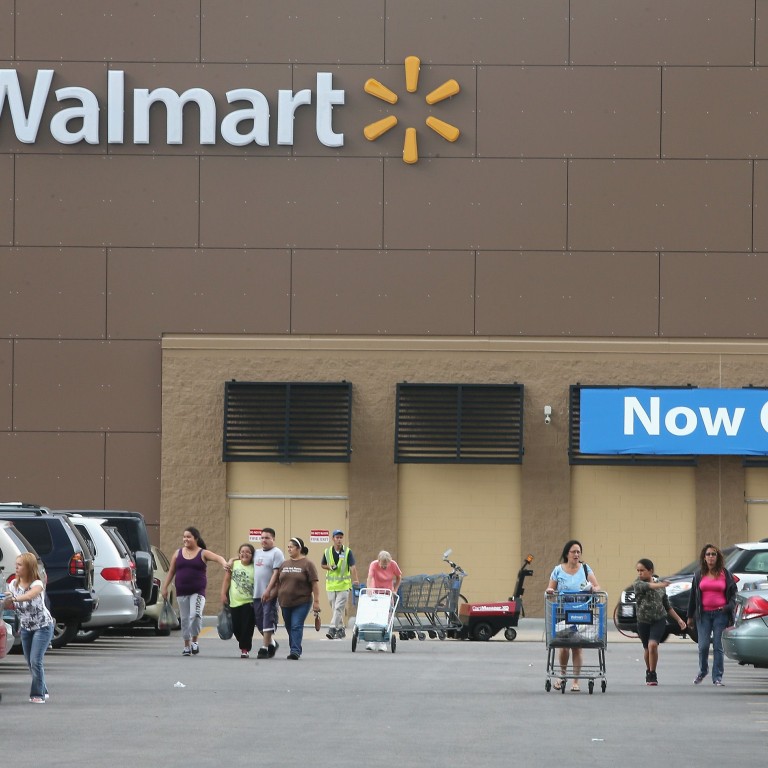
Wal-Mart sales disappoint as US shoppers curb spending
Wal-Mart Stores reported a surprise decline in quarterly same-store sales in the United States, its biggest market, after shoppers came in less often because higher taxes and petrol prices were leaving them with less spending money.
The world’s largest retailer also cut its revenue and profit forecasts for its fiscal year, raising concerns about retail spending as the all-important holiday season nears. It cited weak results from the United States, as well as Canada, Mexico, Japan and other international markets that it is relying on for long-term growth.
Shares of Wal-Mart were down 2.4 per cent at US$74.59 in midday trading.
US sales at stores open at least a year at the company’s main Walmart chain fell 0.3 per cent in the second quarter ended in late July, the company said on Thursday. Wall Street analysts were expecting a 1 per cent gain, according to Thomson Reuters I/B/E/S.
Visits to those stores also fell 0.5 per cent during the quarter.
“That low-income customer is really struggling now, and that’s hitting Walmart,” Edward Jones analyst Brian Yarbrough said.
Shoppers are contending with higher payroll taxes after a two-year cut ended in January, as well as high gas prices and a slow recovery in employment.
Wal-Mart’s results came a week after a group of US retailers reported modest gains in July same-store sales because they had to resort to bargains to lure shoppers who remained careful of their spending.
Wal-Mart expects little improvement going into the fall. It forecast flat US same-store sales in the current quarter, which includes the back-to-school season. Back-to-school is often seen as a barometer for the holiday period, when retailers get about 30 per cent of sales and 40 per cent of profits.
Wal-Mart now expects overall sales to be up between 2 per cent and 3 per cent for the fiscal year, down from an earlier forecast of a rise of 5 per cent to 6 per cent. The retailer also cut its profit outlook by 10 cents per share, to a range of US$5.10 to US$5.30.
“The retail environment was challenging across all of our markets,” chief executive officer Mike Duke said in a recording.
Second-quarter profit rose 1.3 per cent to US$4.07 billion, or US$1.24 per share. Excluding a tax-related charge, earnings were US$1.25 per share, in line with Wall Street estimates.
Revenue increased 2.4 per cent to US$116.2 billion, below the US$118.47 billion analysts expected.
International sales rose 2.9 per cent, not enough to lift the division’s operating profit. The company said it had more work to do to control costs in those markets.
Wal-Mart’s international operating income fell 1.3 per cent. Comparable sales in Canada, Mexico, Japan and Britain fell, while they rose slightly in Brazil and China.
Same-store sales rose 1.7 per cent at the company’s Sam’s Club chain, where shoppers did not baulk at an increase in membership fees in May. Still, Sam’s Club’s same-store sales lagged those of rival Costco Wholesale Corp.
In 2011, Wal-Mart began a probe into alleged violations of the US Foreign Corrupt Practices Act and whether it had handled such matters appropriately.
The situation drew public attention in April last year when the New York Times reported that management at Wal-Mart de Mexico SAB de CV had orchestrated bribes of US$24 million to help it grow quickly in the last decade and that the US parent’s top brass had tried to cover it up.
Wal-Mart said it had spent US$82 million on the probe in the second quarter, after forecasting spending of US$65 million to US$70 million back in May.

